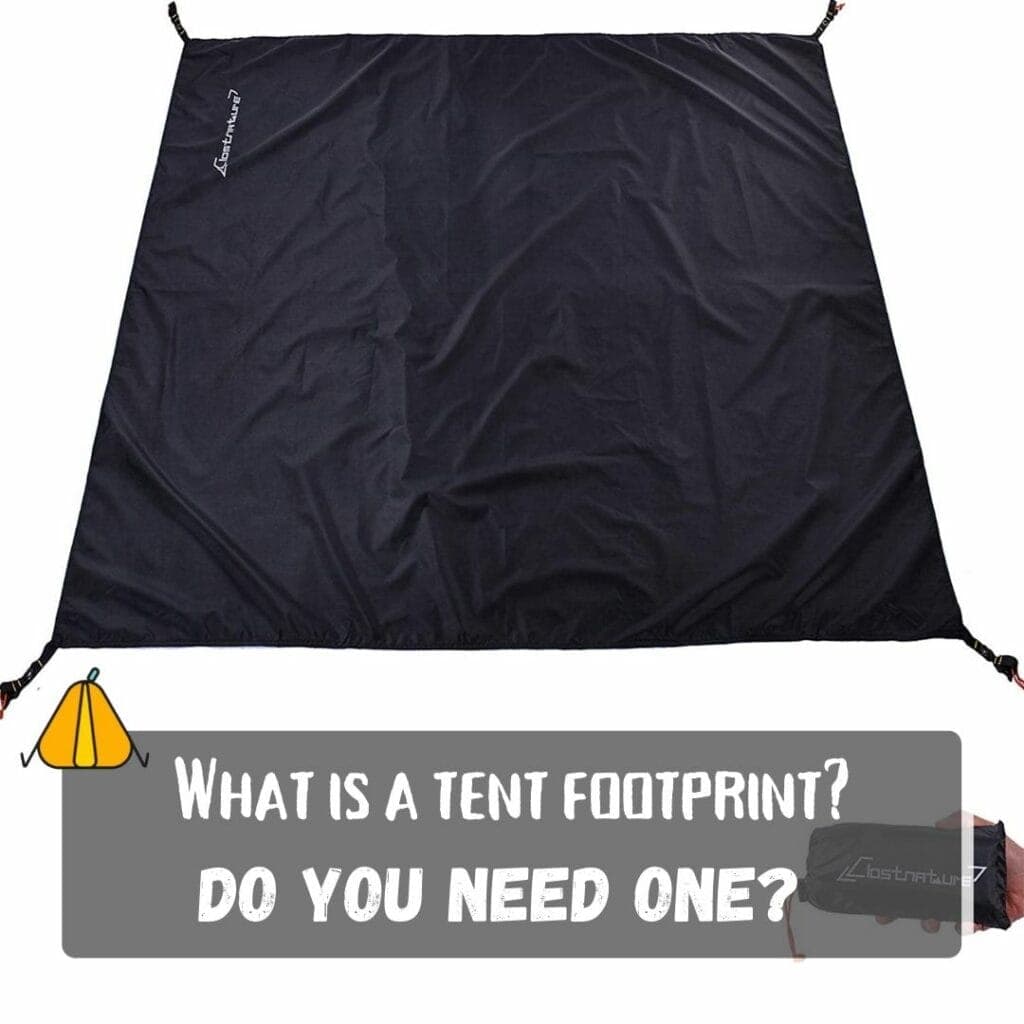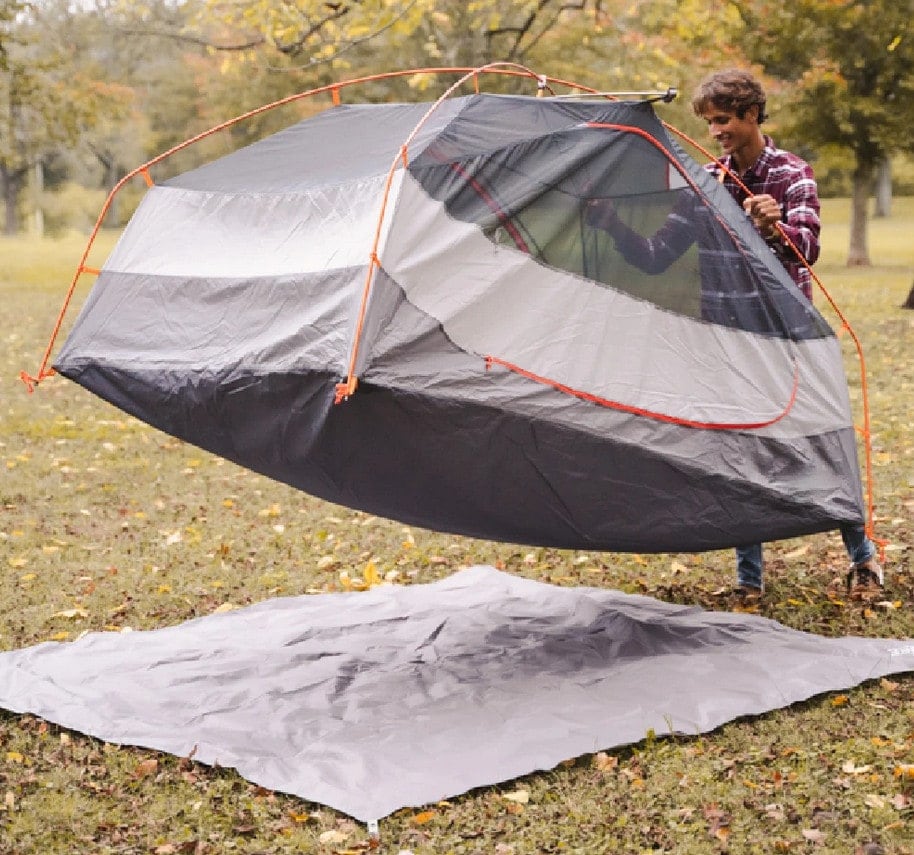A durable, high-quality tent can cost hundreds of dollars. Ideally, you would want something that expensive to last as long as possible.
However, the rough terrain that our tents are often exposed to makes this easier said than done.
If you find yourself in this situation, a tent footprint can be greatly beneficial. Camping experts know what a tent footprint is and the crucial role that it plays.
However, if you are new to camping and don’t know what a tent footprint is, don’t worry.

We will walk you through what a tent footprint is and whether or not you need one. Then, we will answer some of the questions we are frequently asked regarding this item.
What Is a Tent Footprint?
Sometimes called a groundsheet or a ground cloth, a tent footprint is a sheet that is placed between the camping floor and the floor of your tent, like this:

What Does a Tent Footprint Do?
Despite what most people think, the tent footprint’s purpose is not to waterproof the bottom of your tent, as most modern tents are already waterproof. The main role of the tent footprint is to shield your tent floor from abrasive objects like rocks, roots, and sticks.
A tent footprint also helps keep the underside of your tent from getting dirty due to things like tree sap and mud. Let’s look at some of the items a tent footprint protects your tent floor from.
Abrasive Items
Small items like pebbles and twigs might not seem like a major issue. However, continuous abrasion on one spot can cause a hole, especially in thin tent floor fabric. Tent footprints offer an additional layer of protection from abrasive items, ultimately extending your tent’s lifespan.
Awkward Angles
Have you ever tried to pitch your tent in the perfect spot, only to find that there’s an obstacle (usually a tree root) preventing your tent from fitting properly in the desired area? You can use your tent footprint to determine how and where to pitch your tent, essentially removing the guesswork out of spatial planning. This technique can be especially helpful when you want to fit multiple tents on the same site.
Messy Items
Having tree sap stuck all over the bottom of your tent is a headache for most campers. Fortunately, tent footprints can take the brunt of the stains, ensuring that your tent is kept in pristine condition for much longer.
This is especially true if you have a large tent, such as a 14-person tent. These tents are heavier and have a wider surface area, making the bottoms much more easily ripped or torn on the ground.
Ready to buy a Tent Footprint? Click here to see the best prices on Amazon!
How to Know When to Get a Tent Footprint
When trying to determine how useful a tent footprint will be for you and your camping needs, consider the following factors.
Fabric Denier
If you have a tent made from a low denier fabric, then you should strongly consider purchasing a tent footprint if you want to extend your tent floor’s durability. Tents with higher deniers have thicker fabric, so choosing whether or not to get a footprint, in that case, is often a matter of personal preference.
Terrain
Those who do most of their camping in lush, grassy areas or on soft sand could do without getting a tent footprint. However, if your ideal camping trip is in dense forests and mountainous areas, then a footprint is a necessity.
These areas often have an abundance of sticks, roots, and rocks that can wear through your tent’s fabric. Just one perfectly placed twig or pebble can create a hole in your tent floor.
Weight
Since they are a high denier fabric, tent footprints can significantly increase your shelter system’s total weight. If you are an ultralight backpacker who prefers to cut ounces wherever you can, then the standard manufacturer’s tent footprint might not be ideal for you. However, you do have the option of making your own lightweight groundsheet from various footprint alternatives that we will discuss later.
Do You Need a Tent Footprint?
The short answer is yes. Since footprints protect your tent’s floor from a significant amount of abuse, your tent floor will not deteriorate as quickly, which will extend your tent’s overall lifespan.
Also, the tent footprint can take on a lot of the dampness and mud, which can help prevent mildew and mold from building up in your tent.
A tent footprint can allow you to measure your chosen campsite to determine whether your tent will fit or not. You can also use the footprint to determine whether the ground is flat and level.
Lastly, a tent footprint can provide extra cushion and insulation from the ground, as well, preventing your body from feeling the cool temperature of the ground as much.
Tent Footprint Alternatives
As great as tent footprints are, their heavy weight or additional cost might make them less than ideal for you. Fortunately, several footprint alternatives are available that will still offer your tent floor the protection it needs.
1. Window Wrap
A window wrap is a plastic covering that you usually place over your windows during the winter to insulate them. Some of the most popular window wraps include the Frost King Stretch Window Kit and Duck Brand Window Shrink Film.
Window wraps can be excellent tent footprint alternatives, as a single piece of wrap is able to last for an entire season. Some options might last even longer depending on how frequently you use them.
Alternatively, you could also make your own insulated window coverings. We have a guide to creating DIY camper curtains for your car, truck, or camper van.
2. Tyvek HomeWrap
Though it is heavier than a window wrap, this cheap tent footprint alternative is more durable. Tyvek HomeWrap is a type of building material that is used to create a vapor barrier between a house’s exterior siding and interior walls. This material prevents drafts from blowing through the walls, and it is puncture-resistant and waterproof.
Though it’s heavier than a window wrap, Tyvek HomeWrap is still much lighter than a tent footprint, making it an excellent and ultra-light groundsheet alternative. The average weight of a Tyvek wrap ranges from two to five ounces for a single-person tent and five to eight ounces for a two-person tent.
However, the key benefit of using Tyvek HomeWrap over a standard tent footprint is its lower costs. On top of all that, this alternative is very durable and can last for several seasons.
FAQs
To help you gain an even better understanding of tent footprints, we provided the answers to a few questions that campers frequently ask.
Are Tent Footprints Waterproof?
Yes, tent footprints are waterproof. Though their main purpose is to protect your tent floor from abrasive objects, tent footprints still provide an additional layer of waterproofing.
How Big Should a Tent Footprint Be?
We recommend buying a footprint that is about two inches shorter in diameter than your tent’s floor. This way, you won’t need to worry about rainwater getting underneath the shelter and making the ground beneath you damp.
Are Tent Footprints Worth It?
Deciding whether or not a tent footprint is a worthy purchase depends on certain scenarios. A tent footprint is worth it if you:
- Camp on rocky or rough terrain that has areas with lots of downed wood and sharp edges or branches
- Camp frequently and would like your tent to last longer
- Are not concerned with adding a bit of weight and bulk to your camping gear
Can I Use a Tarp as a Tent Footprint?
Yes! While most people use a tarp to protect their tent’s exterior, you can still use it as a tent footprint to protect your tent base from ground debris and other elements.
In Conclusion
Most of us don’t want to replace our tents unless we absolutely have to. However, excessive wear and tear often force us to do so. Fortunately, thanks to tent footprints, we can offer our tent floors the additional protection they need.
A tent footprint is perfect for protecting the tent floor from any punctures or scratches caused by stones, sticks, or sand. If that isn’t enough, these items also do the following:
- Cushion the ground
- Insulate the floor
- Keep your tent clean
- Prevent water from seeping into the tent
With all this in mind, tent footprints just might be the solution to extending your tent’s lifespan.
For more tips, guides, and advice on all the best available camping gear, rigs, and trails, head on over to our blog. If exploring is your passion, Adventures On The Rocks has you covered!
Looking for more articles to read? We’ve got you covered: